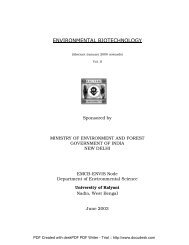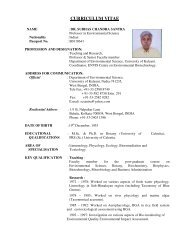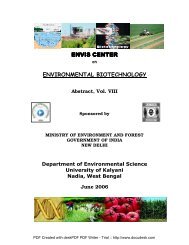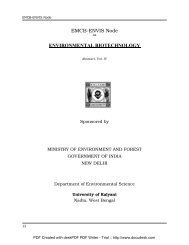EMCB-ENVIS Node ENVIRONMENTAL BIOTECHNOLOGY
EMCB-ENVIS Node ENVIRONMENTAL BIOTECHNOLOGY
EMCB-ENVIS Node ENVIRONMENTAL BIOTECHNOLOGY
Create successful ePaper yourself
Turn your PDF publications into a flip-book with our unique Google optimized e-Paper software.
<strong>EMCB</strong>-<strong>ENVIS</strong> Centre<br />
conventional extraction analysis. The degree of enrichment and the bioavailable metal<br />
concentrations in the sediments of the south portion of Mazatlán Bay is discussed. The potential<br />
ability of C. iridescens as a biomonitor of metallic pollutants is postulated.<br />
M. Topashka- Ancheva, R. Metcheva, S. Teodorova. (Institute of Zoology, Bulgarian<br />
Academy of Sciences, Bd.Tzar Osvoboditel 1, Sofia 1000, Bulgaria. Institute for Nuclear<br />
Research and Nuclear Energy, Bulgarian Academy of Sciences, 72 Tzarigradsko shaussee,<br />
Sofia 1784, Bulgaria). Bioaccumulation and damaging action of polymetal industrial<br />
dust on laboratory mice Mus musculus alba II. Genetic, cell, and metabolic<br />
disturbances. Environmental Research, 92(2) (2003), 152-160.<br />
An ecologo–toxicological experiment was carried out with laboratory mice Mus musculus alba<br />
of the inbred line BALB/c. The experimental animals (male and female) were exposed for 120<br />
days to polymetal industrial dust containing zinc, copper, lead, and cadmium, which was mixed<br />
with conventional animal food. Chromosome aberration frequency and pathological changes in<br />
hematological indices, oxygen consumption, body temperature, and body weight were studied in<br />
the context of heavy metal bioaccumulation and interactions. Samples for analyses were taken on<br />
days 15, 40, 60, and 90. An increased frequency of chromosome aberrations (up to 22%), leadinduced<br />
anemia, and significant decreases in body temperature were observed. A strong<br />
correlation between hemoglobin content and oxygen consumption (O2/ g h) was established. An<br />
increase in hematocrit, accompanied by a loss of body weight after day 60, suggests dehydration<br />
resulting from lead and cadmium poisoning.<br />
Md. Zahangir Alam, A. Fakhru'l-Razia, Abul H. Mollaa. (Department of Chemical and<br />
Environmental Engineering, Faculty of Engineering, Universiti Putra Malaysia, 43400 UPM<br />
Serdang, Selangor DE, Malaysia. Department of Biotechnology Engineering, Faculty of<br />
Engineering, International Islamic University Malaysia, Jalan Gombak, 53100, Kuala<br />
Lumpur, Malaysia). Biosolids accumulation and biodegradation of domestic<br />
wastewater treatment plant sludge by developed liquid state bioconversion<br />
process using a batch fermenter. Water Research, 37(16) (2003), 3967-3977.<br />
The biosolids accumulation and biodegradation of domestic wastewater treatment plant (DWTP)<br />
sludge by filamentous fungi have been investigated in a batch fermenter. The filamentous fungi<br />
Aspergillus niger and Penicillium corylophilum isolated from wastewater and DWTP sludge was<br />
used to evaluate the treatment performance. The optimized mixed inoculum (A. niger and P.<br />
corylophilum) and developed process conditions (co-substrate and its concentration, temperature,<br />
initial pH, inoculum size, and aeration and agitaion rate) were incorporated to accelerate the<br />
DWTP sludge treatment process. The results showed that microbial treatment of higher strength<br />
of DWTP sludge (4% w/w of TSS) was highly influenced by the liquid state bioconversion<br />
(LSB) process. In developed bioconversion processes, 93.8 g/kg of biosolids was enriched with<br />
fungal biomass protein of 30 g/kg. Enrichment of nutrients such as nitrogen (N), phosphorous<br />
(P), potassium (K) in biosolids was recorded in 6.2% (w/w), 3.1% (w/w) and 0.15% (w/w) from<br />
its initial values of 4.8% (w/w), 2.0% (w/w) and 0.08% (w/w) respectively after 10 days of<br />
fungal treatment. The biodegradation results revealed that 98.8% of TSS, 98.2% of TDS, 97.3%<br />
of turbidity, 80.2% of soluble protein, 98.8% of reducing sugar and 92.7% of COD in treated<br />
DWTP sludge supernatant were removed after 8 days of microbial treatment. The specific<br />
resistance to filtration (SRF) in treated sludge (1.4×1012 m/kg) was decreased tremendously by<br />
the microbial treatment of DWTP sludge after 6 days of fermentation compared to untreated<br />
sample (85×1012 m/kg).<br />
Michaël C urdassier, Annette Gomot-de Vaufleury, Christiane Lovy, Pierre-Marie Badot.<br />
(Laboratoire de Biologie et Ecophysiologie (EA 3184 MRT/INRA), Institut des Sciences et<br />
Techniques de l'Environnement, Université de Franche-Comté, Place Leclerc, 25030,<br />
Besançon cedex, France). Is the cadmium uptake from soil important in<br />
34<br />
PDF Created with deskPDF PDF Writer - Trial :: http://www.docudesk.com







